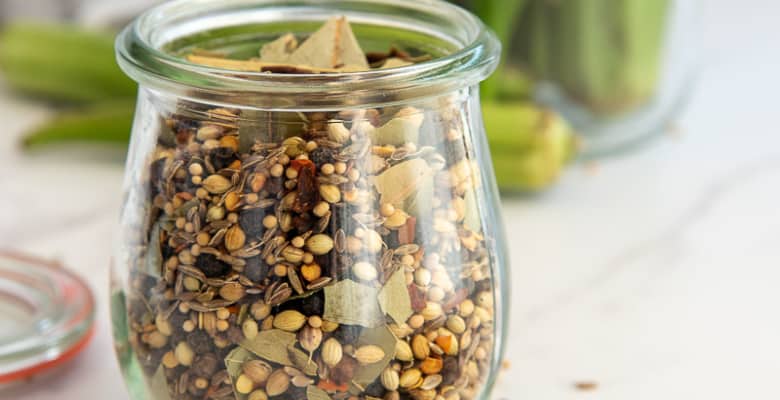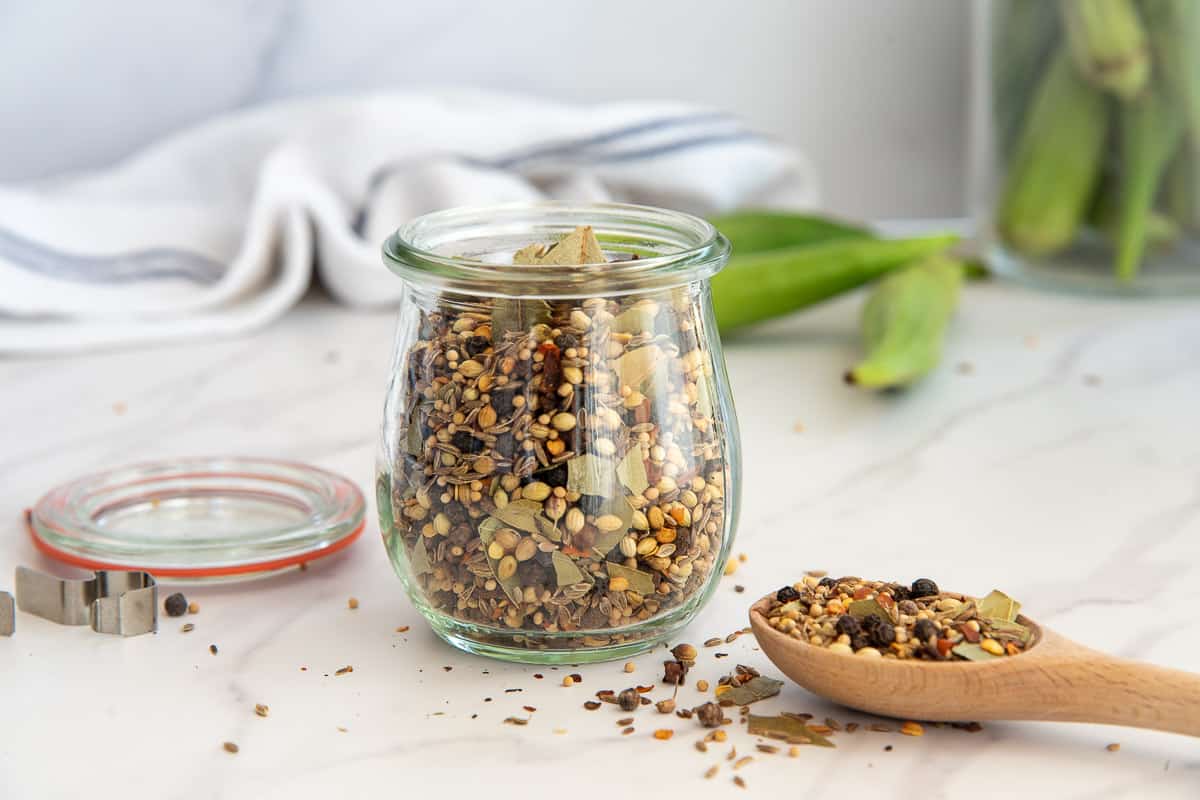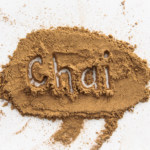My Flavorful Pickling Spice combines black peppercorns, bay leaves, mustard seeds, and many more dynamic herbs and spices that will add interest to any pickled vegetable or fruit you use to pickle with it. You can create a unique pickled condiment with a few tablespoons of this all-in-one blend. What’s especially great about this recipe is that you probably have all the ingredients you need to make it, and it’s ready in less than 10 minutes.
What Is Pickling Spice?
Pickling spice blend is a combination of crushed or whole herbs and spices added to a vinegar and water solution and used to preserve foods. The most common way to use pickling spice blends is for pickling vegetables for long-term storage. The most commonly pickled vegetables are Okra, cucumbers, onions, and carrots. Less common pickled foods are watermelon rinds, pig’s feet, and boiled eggs.
Most pickling blends are sold pre-packaged in this spice aisle and contain the bare minimum of ingredients. Common blends include black peppercorns, coriander, mustard seeds, bay leaves, and allspice. I add more interest to my spice blend, since, as always, I’m extra.
What Is It Made Of?
Black peppercorns, coriander seeds, mustard seeds, allspice berries, and bay leaves are the most common spices in pickling spice recipes. Because I prefer more flavor, I make mine with caraway seeds, cumin seeds, whole cloves, and crushed red pepper flakes, too.
Optional ingredients to add pickling spice are crushed cardamom, fenugreek, juniper, and celery seed.
What Are The Most Important Spices Used In This Recipe?
Again, the base ingredients in pickling spice are black peppercorns, mustard seeds, caraway, and coriander. These four ingredients are all you need to produce a basic pickling blend.
To add more variety, use a combination of black and white peppercorns. Pink peppercorns have a bitter flavor, but you can still use them, especially if you’re adding sugar to your pickling brine.
Can I Replace The Whole Spices With Ground?
Additionally, allspice berries (pimento), cumin, and cloves give this pickling blend a warm, earthy flavor. The cumin and cloves are optional, but I recommend keeping the allspice berries. Allspice resembles black peppercorns, but tastes like a mix of cinnamon, cloves, and nutmeg. This provides your spice blend with a great mixture of seasoning.
Whole or crushed spices and herbs are the only type you should use when making a pickling blend. Ground spices become muddy, both literally and flavor-wise.
How Can I Alter The Flavor Of My Blend?
Add the bay leaves and crushed red pepper flakes.
Toss all the ingredients in a mixing bowl with your hand or a spoon to combine the mixture.
Add ingredients like fenugreek, black or green cardamom, crushed (not ground) cinnamon sticks, fennel seeds, or juniper berries to create your unique pickling spice blend.
How Far Ahead Can I Make Pickling Spice?
As with most seasoning blends, you can mix pickling spice blend a year ahead and use it as needed.
Transfer the pickling spice to an airtight jar or container and label it with the date.
What’s The Best Way To Store Pickling Spice?
Store pickling spice blend in an airtight jar in a cool, dry area of your kitchen for up to one year. Avoid storing spices in hot kitchen areas, specifically near or over the stove or oven.
Fluctuating temperatures cause the spices in the jar to heat up, releasing their natural oils and making them less potent. Additionally, storing spices above the stove, where you boil liquids, causes them to absorb moisture, which can lead to mold forming in the jar.
How Do I Use It?
Use this pickling spice blend in any recipe that calls for it. Use 2-4 tablespoons per 4 cups of liquid. That liquid is usually 3 parts vinegar to 1 part water. Follow the instructions of the pickling recipe you’re using for best results.
I like to use it in brines for things like pork tenderloin, grilled pork chops, or included in a wet brine for turkey or chicken.
How Do I Know If It Has Gone Bad?
Visible mold or a musty smell in your spice blend indicates your pickling spice has gone bad. Rather than risking a foodborne illness, it’s best to discard the blend and make a fresh batch.
Always take precautions to avoid exposing the spice blend to moisture, high temperatures, or direct sunlight, which can heat the herbs and spices.
Can I Use This In Non-Pickling Recipes?
Use pickling spice for recipes other than pickling, such as soups, sauces, or gravies. Pour a teaspoon or two into a sachet bag and tie it to the handle of the stock pot to infuse the warm liquid with tons of flavor.
Making your own spice blends at home is not only economical, but it’s also a great way to show your creativity in the kitchen. Impress your friends and family with a jar of this Flavorful Pickling Spice for the holidays or just because. You’ll always have enough to share since you can make it in bulk. Speaking of sharing, be sure to share this post with your family and friends, and don’t forget to pin it to your condiments board on Pinterest, too!

Flavorful Pickling Spice
at Sense & EdibilityEquipment
- airtight jar or spice container 1 quart
Ingredients
- 2 tablespoons (20 grams) black peppercorns
- 2 tablespoons (20 grams) mustard seeds
- 2 tablespoons (15 grams) cumin seeds
- 1 1/2 tablespoons (12 grams) dill seeds
- 1 1/2 tablespoons (8 grams) coriander seeds
- 2 teaspoons (4 grams) whole cloves
- 2 teaspoons (4 grams) crushed red pepper flakes
- 1/2 tablespoon (4 grams) allspice berries
- 12 large (2 grams) bay leaves crushed
Instructions
Make the Pickling Spice Blend
- Add the black peppercorns, mustard seeds, cumin seeds, dill seeds, coriander seeds, whole cloves, crushed red pepper flakes, allspice berries, and crushed bay leaves to a mixing bowl.
- Use your hand or a spoon to toss the ingredients together until well combined.
Bottle and Store
- Transfer the pickling spice to an airtight jar or container and label it with the date.
To Use
- Use 2-4 tablespoons per 4 cups of liquid.Alternatively, follow the instructions of the pickling recipe you're using for best results.
Notes
Swap and Substitutions:
- To add more variety, use a combination of black and white peppercorns. Pink peppercorns have a bitter flavor, but you can still use them, especially if you're adding sugar to your pickling brine.
- Add ingredients like fenugreek, black or green cardamom, crushed (not ground) cinnamon sticks, fennel seeds, or juniper berries to create your unique pickling spice blend. Use 1- 1 1/2 teaspoons of each.
Tips and Techniques:
- Whole or crushed spices and herbs are the only type you should use when making a pickling blend. Ground spices become muddy, both literally and flavor-wise.
- As with most seasoning blends, you can mix pickling spice blend a year ahead and use it as needed.
Storage Tips:
- Store pickling spice blend in an airtight jar in a cool, dry area of your kitchen for up to one year.
- Avoid storing spices in hot kitchen areas, specifically near or over the stove or oven.
- Fluctuating temperatures cause the spices in the jar to heat up, releasing their natural oils and making them less potent.
- Additionally, storing spices above the stove, where you boil liquids, causes them to absorb moisture, which can lead to mold forming in the jar.
- Visible mold or a musty smell in your spice blend indicates your pickling spice has gone bad, so it's best to discard the blend and make a fresh batch.
- Avoid exposing the spice blend to moisture, high temperatures, or direct sunlight, which can heat the herbs and spices.
Other Ways to Use Pickling Spice:
- Add pickling spice to brines for things like pork tenderloin, grilled pork chops, or included in a wet brine for turkey or chicken.
- Use pickling spice for recipes other than pickling, such as soups, sauces, or gravies. Pour a teaspoon or two into a sachet bag and tie it to the handle of the stock pot to infuse the warm liquid with tons of flavor.

















I used this recipe for brisket and it was soooo good! I have tried other pickling spice recipes before but this one is just perfect. My pastrami came out amazing, so full of flavor.